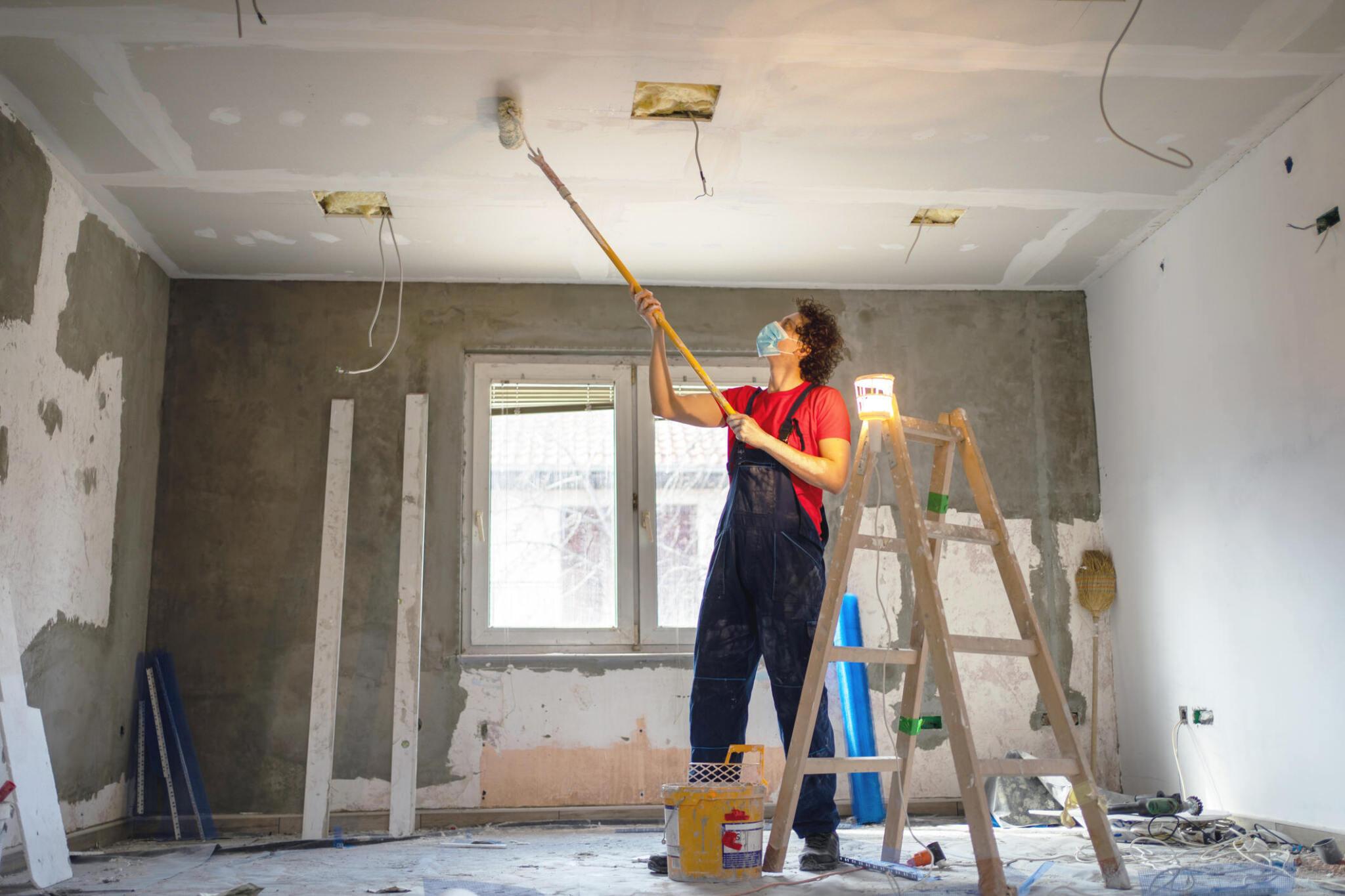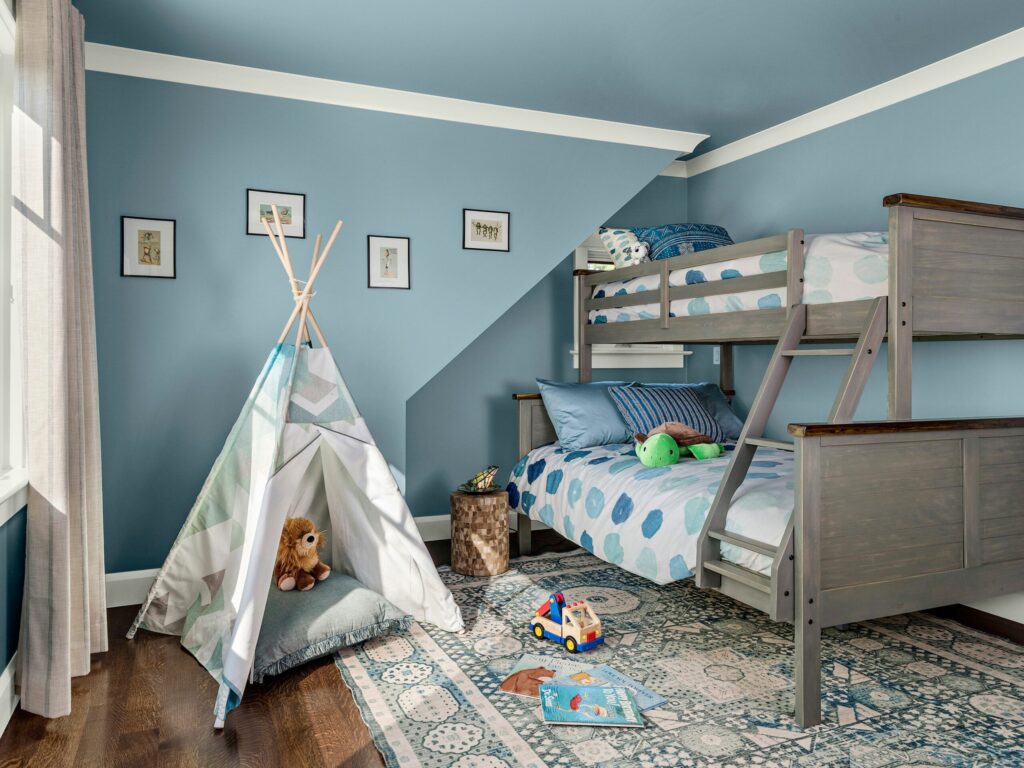
Painting a child’s room can be fun and rewarding, but it requires careful consideration to ensure the result is beautiful and safe. A professional painting company brings a wealth of experience and expertise, offering valuable insights to help you achieve the best outcome.
6 Things to Consider When Painting a Child’s Room
When painting a child’s room, it’s essential to balance creativity with safety and practicality. Here are six crucial considerations to help you create a vibrant, secure, and long-lasting space for your little one.
1. Safety: Use Non-Toxic, Low-VOC Paints
When painting your child’s room, safety should be the top priority. Choosing the right type of paint can significantly impact your child’s health and well-being. One crucial factor to consider is the paint’s Volatile Organic Compounds (VOCs).
What Are VOCs and Their Potential Health Impacts?
Volatile Organic Compounds (VOCs) are chemicals in many household products, including paints. When paint containing VOCs is applied, these compounds are released into the air as gasses, harming human health and the environment. Exposure to high levels of VOCs can cause a range of health problems, including:
- Respiratory issues
- Eye, nose, and throat irritation
- Headaches and dizziness
- Allergic skin reactions
- Long-term health effects, such as liver and kidney damage
Importance of Choosing Non-Toxic, Low-VOC Paints
To ensure a healthier environment for your child, opting for non-toxic, low-VOC paints is essential. These paints significantly reduce the emission of harmful chemicals, making them a safer choice for indoor use. Here’s why you should choose non-toxic, low-VOC paints for your child’s room:
- Healthier Indoor Air Quality: Non-toxic paints release fewer harmful chemicals, improving the air quality inside your home.
- Reduced Allergic Reactions: These paints are less likely to cause allergic reactions, making them ideal for children with sensitivities.
- Environmental Benefits: Low-VOC paints are more environmentally friendly, reducing pollution and contributing to a greener planet.

2. Color Selection: Choose Soothing, Child-Friendly Colors
When it comes to painting a child’s room, the choice of color plays a crucial role in creating a calming and enjoyable space for your little one. A reputable painting company can help you understand the psychological impact of colors and how they can influence a child’s mood and behavior.
Psychological Impact of Colors on Children
Colors can significantly affect a child’s emotions and behavior. Understanding the psychological impact of different hues can guide you in making the best choice for your child’s room. Here are some standard colors and their effects:
- Blue: Known for its relaxing effects on the mind and its ability to soothe the nervous system. It is an excellent choice for creating a calm environment, especially beneficial for children with sleep issues or hyperactivity.
- Green: Associated with nature, green is refreshing and can be calming. It’s also believed to improve concentration and promote relaxation.
- Yellow: A cheerful and bright color, yellow can boost happiness and energy. However, too much yellow can be overstimulating, so it’s best used in moderation.
- Pink: Often associated with feelings of love and comfort, pink can create a nurturing and calming atmosphere. Soft shades of pink are particularly soothing.
- Purple: Combining the calmness of blue and the energy of red, purple can be soothing and stimulating. Lighter shades like lavender are perfect for creating a serene environment.
Suggestions for Soothing Colors
When selecting colors for a child’s room, aim for hues that promote calmness and relaxation. Here are some suggestions from an expert painting company:
- Soft Blues: Light shades of blue, such as sky blue or baby blue, create a serene and peaceful atmosphere.
- Pastel Greens: Soft greens, like mint or sage, bring the refreshing essence of nature indoors.
- Light Pinks: Gentle pinks, such as blush or rose, provide a nurturing and comforting environment.
- Lavender: A light shade of purple, lavender combines the calming effects of blue with a touch of warmth from red.
3. Durability: Opt for a Washable and Durable Finish
Durability is a key consideration when painting a child’s room. Children are naturally active, and their rooms often bear the brunt of their play. Durable paint ensures that the walls can handle impacts, scratches, and scuffs without showing significant damage. This is especially important in a child’s room, where toys, furniture, and even the occasional marker or crayon might come into contact with the walls.
A professional painting company can guide you in choosing paints specifically designed to be tough and long-lasting. These paints maintain their appearance and integrity longer, saving you from frequent touch-ups and repaints.
Benefits of Washable Paint
One of the standout benefits of washable paint is its ease of maintenance. Kids are prone to making messes, whether it’s through arts and crafts, accidental spills, or muddy fingerprints. A washable paint finish allows you to clean the walls effortlessly, keeping the room fresh and tidy.
- Easy Cleaning: Simply wipe down the walls with a damp cloth to remove dirt and stains.
- Maintains Aesthetic: Regular cleaning helps the paint retain its original color and finish.
- Cost-Effective: Reduces the need for frequent repainting, saving money in the long run.
Recommended Finishes
When consulting a painting company, they recommend specific finishes that offer durability and washability. Here are some of the top choices:
- Satin Finish: Known for its slight sheen and smooth surface, satin is durable and easy to clean, making it a popular choice for high-traffic areas.
- Eggshell Finish: This finish offers a subtle, matte finish with a slight sheen that is also easy to clean and more forgiving of surface imperfections.
- Semi-Gloss Finish: Highly durable and washable, semi-gloss is ideal for areas prone to moisture and dirt. It’s slightly shinier than satin and eggshell, adding a bit of gloss to the walls.

4. Child’s Preference: Involve the Child in Color Choices
When painting a child’s room, involving the child in the decision-making process is essential. Doing so empowers them and ensures the room reflects their personality and preferences.
Benefits of Involving the Child in the Decision-Making Process
Involving them in the decision-making process can be incredibly rewarding when decorating and personalizing your child’s room. Here are some key reasons why including your child in their room’s decor decisions is a great idea.
- Sense of Ownership and Pride: Allowing the child to choose the colors gives them a sense of ownership over their space. This can lead to greater pride and responsibility in maintaining their room.
- Enhances Creativity and Confidence: Engaging in the color selection process can boost the child’s creativity and confidence. They learn to express their preferences and make decisions.
- Better Adaptation to the New Environment: When children are involved in decision-making, they are more likely to feel comfortable and happy in their newly painted room, leading to a smoother transition and adaptation.
Tips for Guiding the Child Towards Suitable Choices
While it’s essential to consider the child’s preferences, guiding them toward suitable choices is crucial. Here are some tips from an expert painting company to strike the right balance:
- Offer Limited Options: Provide a curated selection of colors that fit the overall design and are suitable for a child’s room. This prevents overwhelming them with too many choices.
- Use Color Samples and Swatches: Show your child paint samples and swatches to help them visualize the colors. This tactile experience can make the decision process more engaging and accurate.
- Discuss the Mood and Feel of the Room: Explain how different colors can affect the room’s mood. For example, blue can be calming while yellow can be energizing. This helps them understand the impact of their choices.
- Consider Their Favorite Colors: Incorporate shades of their favorite colors. This can be a great starting point, and you can guide them to choose complementary colors for a balanced look.
Examples of How to Incorporate Their Favorite Colors or Themes
Once the child has decided on their preferred colors, a painting company can help incorporate these colors or themes creatively and cohesively:
- Accent Walls: Use their favorite color on an accent wall to make a bold statement without overwhelming the room.
- Themed Murals or Decals: Incorporate themes like animals, space, or nature through murals or removable wall decals that match their chosen colors.
- Furniture and Accessories: Complement the paint with matching or contrasting furniture and accessories. For example, if they choose blue walls, add yellow cushions or a green rug for a pop of color.
- Custom Artwork: Create custom artwork or framed pictures that reflect their interests and chosen color schemes. This adds a personal touch to the room.
5. Fun Elements: Consider Adding Chalkboard or Magnetic Paint
Adding interactive elements like chalkboard or magnetic paint to your child’s room can significantly enhance its functionality and fun. These innovative solutions in a child’s room offer numerous benefits:
- Encourages Creativity: Kids can draw, write, and express their creativity directly on the walls without causing damage.
- Educational Tool: Parents can use these surfaces for educational purposes, such as practicing letters and numbers or even creating fun learning games.
- Versatile Use: These paints can transform any wall into a functional space, perfect for notes, reminders, or fun.
Creative Ways to Use Chalkboard and Magnetic Paint
There are many creative ways to integrate these interactive paints into your child’s room. A professional painting company can help you achieve the best results with these ideas:
- Design a Chalkboard Wall: Dedicate one wall entirely to chalkboard paint, creating a large canvas for your child’s imagination.
- Magnetic Artwork Gallery: Use magnetic paint to create a wall section where your child can display artwork, photos, or school projects.
- Chalkboard Furniture: For a unique and functional touch, apply chalkboard paint to furniture items like desks or the sides of dressers.
- Combination Wall: Combine chalkboard and magnetic paint in one area, allowing for a dual-purpose interactive space.
6. Ventilation: Ensure Proper Ventilation During and After Painting
Ensuring proper ventilation is crucial for safety and efficiency when painting a child’s room. Adequate airflow helps to dry the paint quickly and prevents the buildup of harmful fumes, creating a safer environment for your child. Effective ventilation also helps to dissipate paint odors more quickly, making the room more comfortable.
Tips for Maintaining Good Airflow During and After the Painting Process
Maintaining good airflow during the painting process is essential. Here are some tips from a painting company to ensure proper ventilation:
- Open Windows and Doors: Open windows and doors whenever possible to create a cross-breeze that can carry fumes outside.
- Use Fans: Place fans in the room to circulate air and direct fumes from the windows.
- Ventilation Systems: If your home has an HVAC system, use it to enhance airflow. Ensure vents are open and unobstructed.
- Avoid Closing the Room: Do not close the room immediately after painting. Allow ample time for the paint to cure before closing doors and windows fully.
How to Choose a Painting Company to Paint Your Child’s Room
Painting your child’s room is an important project that requires careful consideration. The right painting company can ensure that the job is done safely, efficiently, and to your satisfaction. Here are some essential steps and tips to help you choose the best painting company for your child’s room.
Research and Referrals
Start by researching local painting companies. Ask friends, family, and neighbors for recommendations. Personal referrals are often the most reliable source of information. Check online reviews and ratings, look at the company’s portfolio on its website, and ensure it specializes in residential painting.
Check Credentials and Insurance
Ensure that the painting company you choose is licensed and insured. This protects you from liability in case of accidents or damages during the painting process. Verify their credentials, including a valid business license, general liability insurance, and worker’s compensation insurance.
Ask for Detailed Estimates
Contact several painting companies to get detailed estimates. This will help you compare prices and understand what is included in their services. Look for a breakdown of costs, including labor and materials, an estimated time frame for completion, and terms of payment and warranty information.
Assess Their Experience with Children’s Rooms
Not all painting companies have experience with painting children’s rooms. Ask about their specific experience and any special considerations they take into account. Questions include whether they have painted children’s rooms before, what safety measures they implement, and if they can provide examples of previous work.
Verify the Use of Safe, Non-Toxic Paints
A reputable painting company should prioritize your child’s safety by using non-toxic, low-VOC paints. Ensure they are knowledgeable about these products, which reduce exposure to harmful chemicals, are safer for children with allergies or asthma, and are environmentally friendly.
Evaluate Their Professionalism
The painting company’s professionalism can be gauged by its communication, punctuality, and thoroughness of initial consultation. Signs of a professional painting company include prompt responses to inquiries, clear and detailed communication, and a professional demeanor and appearance.
Review the Contract Thoroughly
Before hiring a painting company, review the contract carefully. Ensure all details are precise and agreed upon. Critical elements of a painting contract should include the scope of work, payment schedule, warranty and guarantees, and a timeline for completion.
Look for Added Value Services
Some painting companies offer additional services that can add value to your project. This might include color consultation, surface preparation, and minor repairs. These services can enhance the overall quality and outcome of the project.
Consider Their Reputation and Stability
Choose a painting company with a solid reputation and stability in the market. This indicates reliability and the likelihood that they will be around to honor any warranties or future needs. Assess their reputation by looking at their longevity in the business, customer testimonials, and any accreditation from industry organizations.
Ensure Clear Communication Throughout the Project
Effective communication is key to a successful painting project. Ensure that the painting company provides regular updates and is responsive to your questions and concerns. Establish a primary point of contact, agree on regular update intervals, and ensure prompt responses to any issues or changes.
Frequently Asked Questions
What should I look for when hiring a painting company?
When hiring a painting company, look for experience, a solid track record, and positive customer testimonials. Ensure they are licensed and insured to protect against liabilities. Choose a company that provides detailed, written estimates outlining the scope of work, timeline, and costs. Good communication and responsive customer service are also essential.
How do painting companies estimate the cost of a project?
Painting companies estimate project costs by assessing the size and complexity of the area, the type and quality of paint and materials, and labor costs. They consider preparation work, such as surface cleaning and repairs, as well as overhead and travel expenses. Many companies conduct on-site inspections to provide accurate estimates.
How do painting companies handle unexpected issues during a project?
Painting companies handle unexpected issues by maintaining open communication and having contingency plans. They inform clients of problems, such as hidden damage or adverse weather, and discuss solutions. Experienced companies adapt quickly, revise estimates if needed, and seek client approval before making significant changes.
What type of paint is best for exterior versus interior surfaces?
Use durable paints like acrylic latex for exterior surfaces, which withstand harsh weather and UV radiation. Interior surfaces benefit from latex or acrylic paints, which offer easy application, low odor, and quick drying times. High-traffic areas or moisture-prone rooms should use paints with satin or semi-gloss finishes for extra durability.
How should I prepare my house for painting?
Prepare your house for painting by removing furniture and decorations and covering floors and remaining items with drop cloths—clean surfaces to remove dirt and grease and repair any damages. For exteriors, power wash and scrape off loose paint. Ensure surfaces are dry before applying primer, and choose a suitable painting day with optimal weather conditions.
Transform Your Child’s Room with Custom Colonial Painting in Westport, CT!
Ready to create a beautiful and safe space for your child? Custom Colonial Painting in Westport, CT, specializes in painting children’s rooms with attention to detail and focusing on non-toxic, child-friendly products. Our experienced team will work with you to choose the perfect colors and finishes, ensuring a room that your child will love. Contact us today to schedule your consultation and see why families in Westport, CT, trust us for their home painting needs!



